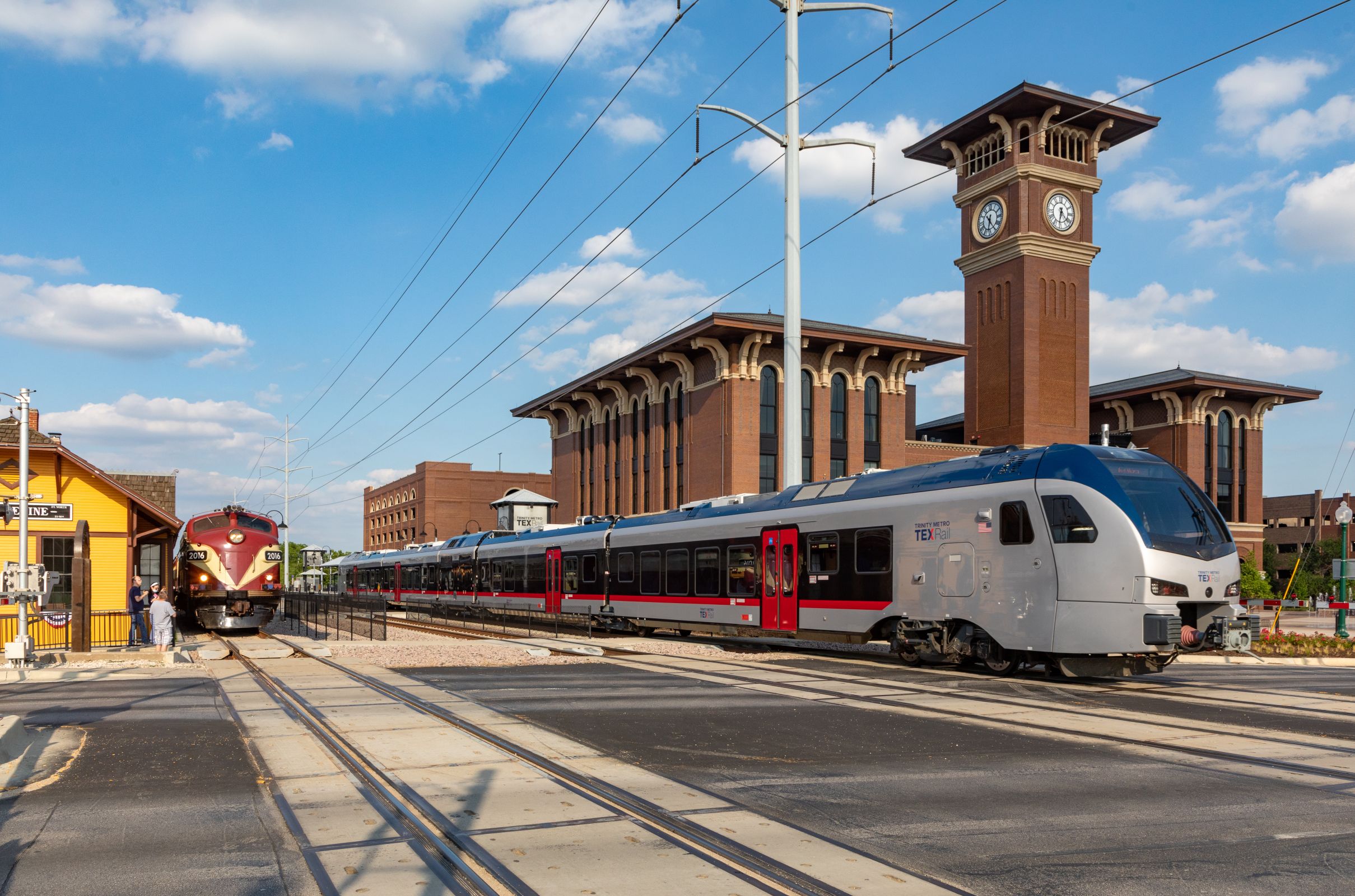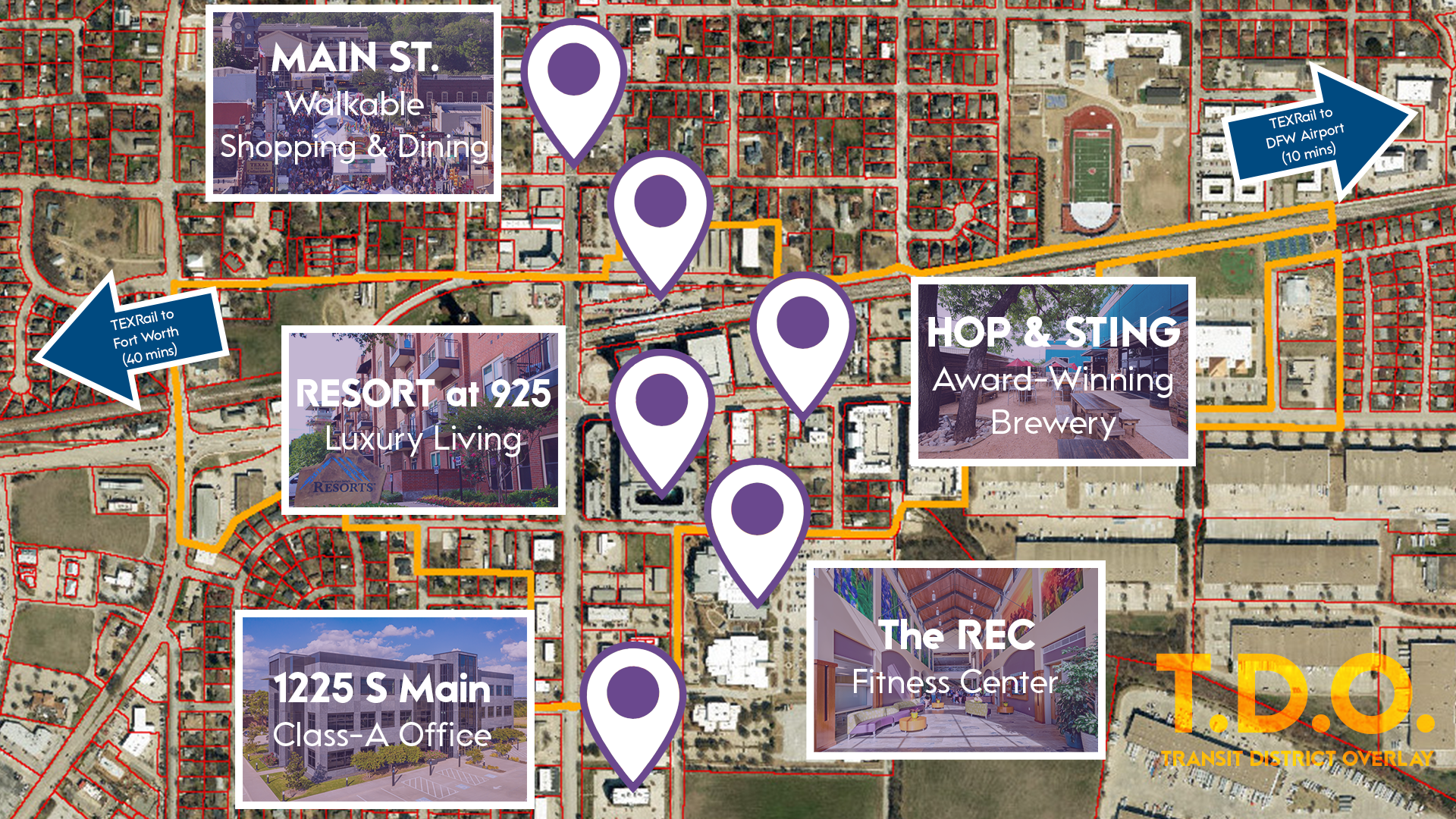'Just the Beginning' - A Closer Look at Grapevine's Transit District Overlay

1 Feb 2022
News, Blog
North Texas is one of the fastest-growing metropolitan areas in the United States by almost every metric. The region ranks among the most popular destinations for both U-Haul traffic and hired moving services. Perhaps because of that migration boom, the state was also the fastest to overcome job loss caused by the economic shutdown back in March of 2020. DFW is also the second-biggest market for corporate logistics projects in the US.
If supply chain headaches have taught us anything over the last year, it’s that accessibility is invaluable. Seated in the heart of North Texas, the City of Grapevine has a unique advantage in that regard. Seven highways come together just south of city hall, with a 27-mile commuter rail line nestled in between. Every fifteen minutes, a train departs for either the City of Fort Worth or DFW International Airport. And every terminal at DFW International – a top-5 hub for passenger and cargo traffic throughout the country – is built on Grapevine soil.
And we’re only just beginning to understand the economic power of the region.
A New Era of Access
As far back as the late 1800s, this City was a rallying point for regional commerce. Back then, it was freight cars that converged on Main Street, linking farmers and vendors to distant buyers along the Cotton Belt line. Nowadays, those rails have found a new purpose.
“A lot of the success that we’ve had in Grapevine is geographic. Back in the 1800s, where we were centrally located, it made sense to put the rail right through here. Now we’re having that benefit again in the 21st century,” said Paul Slechta, a City Council Member who also sits on the Board of Directors at Trinity Metro.
 “In the late 1800s and 1900s, they were moving a different type of product. Whether it was cotton [or something else], it was a different industry. Now, we’ve come full circle to where we’re more or less moving people. Because it’s cheaper to move people via commuter rail, just like it was cheaper to move product via train than, say, wagons.”
“In the late 1800s and 1900s, they were moving a different type of product. Whether it was cotton [or something else], it was a different industry. Now, we’ve come full circle to where we’re more or less moving people. Because it’s cheaper to move people via commuter rail, just like it was cheaper to move product via train than, say, wagons.”
Several years ago, Grapevine led the charge to bring the TEXRail commuter line into operation, investing millions of dollars into a top-of-the-line station paired with a boutique hotel and European-style food hall. Ridership dwindled briefly at the height of the coronavirus pandemic, but foot traffic has come roaring back as the world recovers. Main Street set a record for holiday visitors in December, partially because of the access and awareness brought by the train. Trinity Metro reports that the Grapevine station is the most popular weekend stop along the route, and plans to link the station to North Texas via the Silver Line route by 2026.
“It’s just beginning, in my opinion, with the Transit District around Hotel Vin and down Dallas Road. I can’t wait to see what it looks like in ten, fifteen years,” Slechta said. “The train station and the hotel have allowed the opportunity to take Dallas Road – which was originally just an industrial thoroughfare with a lot of metal buildings – into people having a vision for what it could actually be. Softening the road, making it nicer and more pedestrian-friendly, has [encouraged that]. It’s going to be exciting.”
The Power of People and Place
As the Executive Vice President of Economic Development for the Fort Worth Regional Chamber, Chris Strayer has a good sense of why companies choose to relocate into North Texas. His team oversees a broad swath of initiatives, from business attraction and retention to workforce development. There are a lot of moving parts, but he’s never struggled to keep the project pipeline full.
“We did 85 Request for Information responses [RFIs] in 2019. We did 120 in 2020, during COVID. And last year, 2021, we did 150. There’s more and more interest in the area and it’s going to continue to grow,” Strayer said.
“The number one question we get asked as Economic Developers when [a company] is looking to make a new investment or relocation is talent; can we find the people we need to be successful? When you’re growing by 400 people a day, that’s obviously where your workforce is. We get invited to the dance a lot just because of that growth.”
The flood of talent into North Texas attracts more businesses, which in turn draw new talent. It’s a virtuous cycle fueled by the State’s business-friendly policies and low tax rates, aided in this region by top-notch accessibility. DFW Airport has one of the most robust outbound flight schedules in the world and usually ranks in the top 5 domestic airports for both cargo and passenger travel. The geographic advantage of hosting that airport is tough to overstate; especially when blended together with a City strategy designed to optimize that access.
“It’s a great place to be able to get goods in and out very quickly,” Strayer said. “That’s a huge deal. I’ve worked on several projects where the company has said they want to be within a 15-minute radius of the airport... the other aspect, especially with offices and headquarters, is that the quality of life in Grapevine is amazing. The downtown is amazing. Anybody I’ve ever taken through from a project standpoint has been amazed with the town. There’s a lot of value in Grapevine.”
To hear more about the accessibility and opportunity created by the burgeoning Transit District Overlay, check out the latest episode of the Growing Grapevine podcast.
More Topics

Texas NO. 1 In Trade, FDI
Feb 1 2022
Texas Adds Tier 1, Tier 2 Universities In 2021
Jan 31 2022





